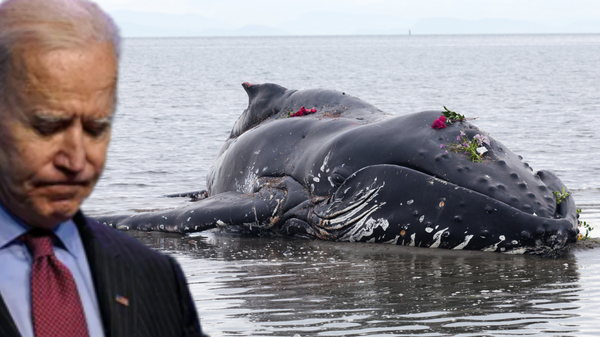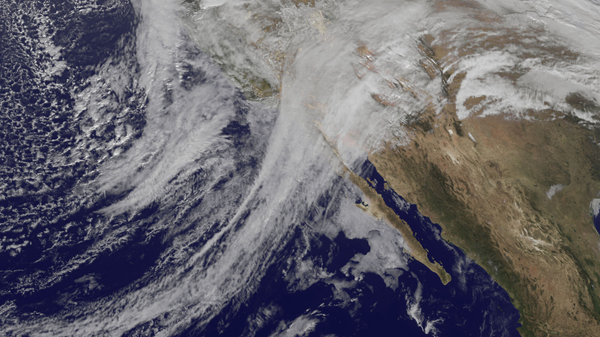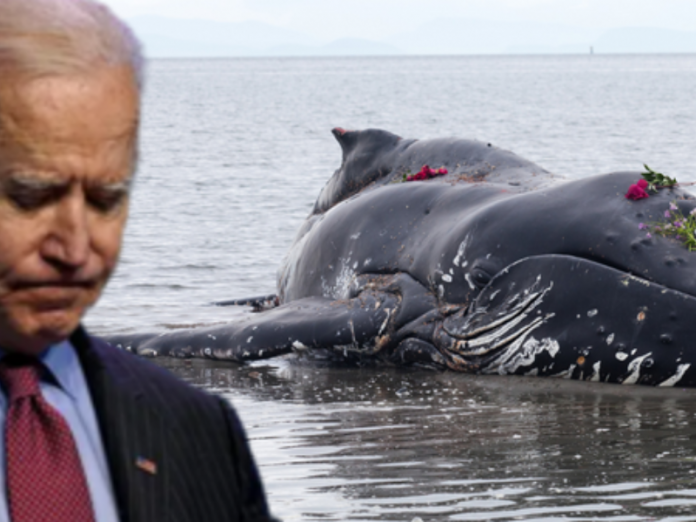YOU SHOULD SUBSCRIBE TO CLIMATE CHANGE WEEKLY.
IN THIS ISSUE:
- Biden Offshoring Pollution, Environmental Injustice
- Podcast of the Week: Socialism Will Not Win Despite the Current Energy/Supply Crises (Guest: Jay Lehr)
- India Goes All-in on Coal
- Atmospheric Rivers Are Nothing New
- Video of the Week: Resignation Due to Academia’s Climate Corruption
- BONUS Video of the Week: Jay Lehr on getting rid of the U.S. EPA
- Climate Comedy
- Recommended Sites
Biden Offshoring Pollution, Environmental Injustice

In pursuit of President Joe Biden’s stated goal of reducing U.S. greenhouse gas emissions 50 percent below the 2005 level by 2030, the White House has initiated efforts to build 30,000 megawatts of traditional offshore wind facilities (with structures attached to the ocean floor) in federal waters by 2030, plus 15,000 megawatts of floating industrial offshore wind power generation by 2035.
To meet those goals, Biden and company will have to approve building thousands of huge offshore turbines, towering up to 620 feet above the water, over thousands of square miles of ocean. The Biden administration is soliciting leases in federal waters in the Gulf of Mexico and Gulf of Maine and off the coasts of New England, the mid-Atlantic states, North Carolina, South Carolina, California, and Oregon.
In an earlier CCW, I discussed the terrible threat the Biden administration’s grandiose and economically and environmentally unjustified offshore wind plans pose to the survival of endangered North Atlantic Right Whales.
The threat to whales is hardly the only problem with Biden’s plan, as proven by an analysis of the Bureau of Ocean Energy Management’s (BOEM) draft Environmental Impact Statement (EIS) for the Coastal Virginia Offshore Wind Project (CVOWP). The CVOWP EIS is so inadequate and incomplete that it can fairly be labeled arbitrary and capricious. That would open it, and any permits that flow from it, up to legal challenges. What’s true of the CVOWP EIS is probably equally true of those for the entire range of wind projects now in the planning, leasing, permitting, exploration, or construction phases along the U.S. east coast, the Gulf of Mexico, and California.
Among the myriad problems I have identified when examining the CVOWP draft EIS is its artificially constrained assessment of the project’s effects on air quality and environmental justice. In a highly controversial and legally contested move, the Obama administration set a new standard for environmental reviews by federal agencies such as the U.S. Environmental Protection Agency, the Department of Energy, the Federal Energy Regulatory Commission, and the Interior Department. It began to lard up the traditional and legally required calculation of the domestic benefits and costs of proposed actions with purported benefits of proposed rules and executive actions to people in other countries. The Biden administration has not disavowed that decision, as it should, but has instead embraced it. For example, Biden touted the global impact of his decision to cancel the Keystone XL pipeline project and his push for rapid expansion of renewable energy and electric vehicle use in the United States.
If the administration believes it is legitimate to count benefits to public health, the environment, and the climate in other countries in its calculation of the benefits of U.S. executive agency actions, it should also include the short-term, long-term, cumulative, and permanent costs or likely negative consequences of its actions in its Environmental Impact Statements.
For every offshore wind project, this would require accounting for worldwide air quality effects of the mining, refining, manufacturing, and transporting of the huge amounts of rare earth elements and critical minerals vital to the manufacturing and functioning of the magnets used in offshore wind turbines, the cables and stations used to transmit and transform the electricity produced from turbine to final destination, and the massive battery backups to maintain the electric power supply and reliability undermined by the intermittent nature of offshore wind.
The International Energy Agency notes offshore wind requires more scarce minerals, rare earth elements, and other critical metals per kilowatt hour of energy produced than any other source of electric power generation, renewable or nonrenewable. The vast majority of these critical minerals and elements are mined abroad, and almost all the refining is done in China.
A single onshore wind turbine requires up to three metric tons of copper and magnets, composed in large part from rare earth elements difficult to mine and refine. Much-larger offshore wind turbines will require even more copper and magnets with rare earth elements. Thousands of pounds of ore must be mined to produce a single pound of these rare earth elements, and even more for the combination of rare earth elements required for the magnets used in wind turbines. Then there are the metals and sheathing for the cables and transformers. In addition, between 200,000 and 1.5 million pounds of earth must be mined and moved to produce the lithium, cobalt, copper, nickel, and other metals and trace elements necessary to produce a battery pack for a single electric vehicle.
This means hundreds of billions of tons of these minerals will have to be mined and refined to produce the thousands of batteries that will compose the large-scale facilities used to back up and regulate the electricity produced by the Biden administration’s planned offshore wind projects.
In addition to the water-polluting toxic sludge produced during the refining process, mining produces dust, and the factories refining it emit air pollution. The fact that the air pollution occurs thousands of miles away in countries with few or no environmental protection laws and limited or nonexistent enforcement—certainly nothing comparable in stringency to those of the United States—should not exempt the BOEM from acknowledging the air pollution produced in building our offshore wind industrial facilities. These emissions, contrary to the BOEM’s claims based on its limited accounting, are likely to be major and negative, not minor, moderate, or beneficial.
The federal government requires fossil fuel-related energy and transportation infrastructure projects to account for all emissions from production to final use in the EISs required to justify new pipelines and other projects. It hardly seems reasonable for companies involved in offshore wind development not to be held to the same standard.
And since the vast majority of the emissions from activities devoted to discovering, acquiring, refining, producing finished products, and transporting the vast majority of the raw material and finished products used in assembled turbines will be produced far away, it is arbitrary and capricious for the BOEM to limit its accounting for air emissions to “the airshed within 25 miles (40 kilometers) of the Wind Farm Area (corresponding to the OCS permit area) and the airshed within 15.5 miles (25 kilometers) of onshore construction areas and ports that may be used for the Project.” Every offshore wind project considered by the BOEM will cause profound emissions far beyond the immediate area of construction and operation.
In all its regulations and EISs, the Biden administration is careful to highlight and account for the expected “environmental justice” effects of a proposed rule or project. The CVOWP EIS is no different in this regard, with the White House claiming the effects will be “negligible,” “minor,” or even “beneficial,” depending upon the alternative chosen. This position is untenable if one considers the broader, comprehensive environmental justice effects, cradle to grave, of the CVOWP and other offshore wind developments.
Congo is the largest producer of cobalt, which is necessary for technologies critical to Biden’s net-zero goals. Cobalt is an essential component of offshore wind turbines. Most cobalt in Congo is mined under appalling working conditions at small mines. Child labor is not the exception but the norm there. The Biden administration’s State Department has acknowledged child labor is rife in the production of cobalt. Increasing the demand for cobalt will raise the pressure on miners to produce, meaning more children will be put to work or current child laborers will be forced to work harder and longer hours under dangerous conditions. These facts hardly show concern for environmental justice.
In China, the source of most raw minerals and finished green energy products and most of the world’s mineral refining capacity, forced or slave labor is common. Much of this involves persecuted religious minorities such as the Falun Gong and Uighurs. The Biden administration has acknowledged this problem, signing the Uighur Forced Labor Prevention Act in 2021 and blocking the importation of thousands of Chinese-made solar panels. Still, the reality of today’s supply chain, combined with insufficient intelligence on the ground to track forced labor in manufacturing and still less in the development of raw materials, it is likely every offshore wind turbine will be built using or containing minerals, rare earth elements, and parts produced through the exploitation of slave labor. The BOEM should consider this in its assessment of the environmental justice implications of every offshore wind project proposed. Failure to do so is arbitrary and capricious.
The U.S. government should not be offshoring its pollution when constructing offshore wind facilities, nor should it ignore the environmental justice considerations in the creation of their core components. If such concerns can be ignored in the BOEM’s EISs for the CVOWP project and others, Biden should not use them to limit oil and gas leasing, production, and transportation projects in the United States.
Even if reducing greenhouse gas emissions to prevent dangerous climate change were a worthwhile goal (which, of course, I doubt), constructing thousands of huge offshore wind turbines would be an environmentally destructive, unjust, and economically foolish way to go about it. Biden should not ignore the negative effects of his climate and energy policies on the global community.
If we are to believe Biden’s rhetoric, climate change is a global problem. Therefore, assessing the global effect of U.S. climate policies is not just justified but virtually required from the moral, political, environmental, and economic points of view.
Sources: Climate Change Weekly; International Energy Agency; Bureau of Ocean Energy Management
Podcast of the Week
Zero-emission energy mandates are undermining grid reliability and substantially increasing energy costs in Minnesota and Wisconsin. These mandates pose similar problems for the grid nationwide. Public utilities are profiting from the legislative push for zero-emission energy mandates. Unfortunately, these mandates increase the amounts of expensive, intermittent wind and solar added to the grid. increasing black outs and brown outs.
Legislators should put an end to the premature retirement of existing coal plants to ensure grid reliability. Reliability, not fighting climate change, should be the primary goal of public utility commissions.
Subscribe to the Environment & Climate News podcast on Apple Podcasts, iHeart, Spotify or wherever you get your podcasts. And be sure to leave a positive review!
Get your Copy at Amazon TODAY!
India Goes All-in on Coal

In response to complaints from the states of Maharashtra and Gujarat that companies in India’s industrial heartland have insufficient access to electricity, Reuters reports India’s national government will require power plants that use imported coal maximize their output.
The government is using an emergency law for the second time in two years in anticipation of record demand this summer. According to Reuters:
Many Indian coal-fired plants, including those owned by Adani Power (ADAN.NS) and Tata Power (TTPW.NS) in India’s western Gujarat state, have not operated at full capacity in the recent years because they have found it difficult to compete with power generated from cheap domestic coal.
The Indian government has promised to work with the power plants using imported coal, which costs more than domestic coal, to reduce the cost of operations and service any debt undertaken to keep the plants fueled and operating at maximum capacity.
Indian authorities estimate the nation’s power plants will have to burn approximately 8 percent more coal in the fiscal year ending March 2024 to maintain grid stability and provide sufficient power for expected economic growth.
Source: Reuters
Atmospheric Rivers Are Nothing New

The West Coast of the United States has experienced repeated strikes from “atmospheric river” events dropping large amounts of precipitation in a fairly short time, resulting in large-scale flooding and some deaths. Mainstream media outlets have written dozens of stories over the past two months discussing atmospheric rivers.
Sadly, many news organizations, such as The Washington Post, ABC News, and The New York Times, have tried to blame climate change for the heavy rainfall and associated property damage and lives lost through atmospheric river events. Outlets highlighted in a recent Climate Realism post, by contrast, set aside the climate crisis narrative and checked the facts, accurately reporting atmospheric rivers have been around since time immemorial and there is no evidence climate change has made them more powerful or frequent.
In an effort to inform legislators and the concerned public and debunk claims made by those who capitalize on misery for political ends, The Heartland Institute recently published a new paper in our Climate at a Glance series explaining what atmospheric rivers are and showing there is no evidence they are being made more severe by climate change. The paper was written by meteorologist Anthony Watts.
Watts makes three key points in the paper: (1) atmospheric rivers are natural and normal parts of global weather patterns, happening on the West Coast every one to three years on average; (2) geology has shown extreme atmospheric river events occurred on the U.S. West Coast as far back as A.D. 212, occurring on average every 200 years; and (3) claims that climate change is making atmospheric rivers more severe are not supported by observational evidence, research on the phenomenon, or computer model projections.
Watts concludes, “The long-term observational and paleoclimatological records provide no support for claims that AR events have become more frequent or severe during the recent period of modest warming.”
I encourage you to read Watts’ paper in full and share it widely.
Source: Climate at a Glance: Atmospheric Rivers
Heartland’s Must-read Climate Sites
Resignation Due to Academia’s Climate Corruption
Recently on Twitter, there was an openly raw admission of why academia has descended into little more than intellectual tribalism. Climate change was at the center of the issue.
In this episode of Heartland’s Climate Change Roundtable, former professor Dr. Matthew M. Wielicki joins the show. Dr. Wielicki decided to leave the University of Alabama, citing personal reasons, as well as the clear rise of wokeness and protectionism over truth when it comes to climate science. He said “I feel the profession…is no longer worthy of my efforts.”
Climate Lunacy and Unhinged Hypocrisy
In episode #48 of Climate Change Roundtable, Anthony Watts, H. Sterling Burnett, and Linnea Lueken look at the craziest things that have happened in the clima-sphere over the past two weeks.






 via Comically Incorrect
via Comically Incorrect























 EV Dangers Daily Becoming More Evident...
EV Dangers Daily Becoming More Evident...
[…] From Heartland Daily News […]